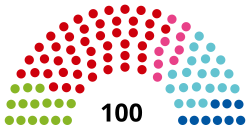Municipal Council and Landtag of Vienna
Gemeinderat and Landtag of Vienna Wiener Gemeinderat und Landtag | |
|---|---|
 | |
| Type | |
| Type | |
| Houses | Gemeinderat Landtag |
| History | |
| Founded |
|
| Leadership | |
Chairman of the Gemeinderat | SPÖ) |
| Structure | |
| Seats | 100 |
 | |
Political groups | Government (54)
Opposition (46)
|
Length of term | five years |
| Elections | |
Last election | Rathausplatz, Vienna |
| Website | |
| wien.gv.at | |
As
While the municipal council and the state parliament consist of the same members, they meet separately, complete with separate presiding officers: the chairman of the Municipal Council and the President of the Landtag. This is because the Vienna City Constitution requires city and state business to be kept separate. When the deputies meet as the Municipal Council, they can only deal with matters of the city, but not the affairs of the state. When the deputies meet as the Landtag, they may only deal with the matters of the state, but not the affairs of the city. Thus, the legal situation in Vienna is different to that in other city-states such as Berlin or Hamburg.
Gemeinderat of Vienna
The Gemeinderat, formed for the first time after the revolution in 1848 on the basis of the provisional municipal law of March 17, 1849,[1][2] issued by the imperial patent, was correspondingly enlarged in the following decades. After the incorporation of Floridsdorf in 1904/1905[3] the Gemeinderat comprised 165 representatives until 1923. The legal provisions for this were decided by the Landtag of Lower Austria as the State Law.
The municipal council could only be elected by all citizens living in Vienna after 1918. Before then, the leading classes of Vienna and Lower Austria had prevented the general right to vote, realized for men in Cisleithania in 1907, in the municipal and state policy.
In the Vienna city constitution, the Gemeinderat is mentioned before the Landtag, as was decided by the
In 1923, the number of representatives in the Gemeinderat/Landtag was reduced to 120,[4] and in 1929 (first applied in the 1932 election) to 100[5] (the number it still has today).
In the Austrofascist dictatorship of 1934-1938, the municipal council was replaced by the parliament of Vienna.
The Gemeinderat has elected the mayor (who since November 10, 1920, also serves as the Landeshauptmann, or governor of the state of Vienna) and the (executive) city councils since June 1, 1920. These have also functioned simultaneously as members of the Viennese regional government since November 10, 1920. In addition, the Gemeinderat controls all other community bodies and decides on budget and clearance (including the state budget, which is not separate).[6] It also decides on all the city's major expenditures, the city plan, the service plan and the business division for Wiener Stadtsenat and the Viennese provincial government. It is, therefore, a very busy body, also with the municipal councils for the individual business groups of the magistrate. The municipal council is to be understood legally as an organ of the executive branch, since municipalities in Austria do not have their own legislation, but have to implement federal and state laws.
Since 1918, the
Landtag of Vienna
The Municipal Council of the city of Vienna has also functioned as the Landtag of the State of Vienna since November 10, 1920. On that day, the
The Landtag has the right to legislate for provincial and constitutional laws; state competencies are determined by the
Meeting place
Until June 20, 1885 the Gemeinderat met in the meeting room in the
See also
- Distribution of seats in the Austrian Landtage
References
- ^ RGBl.
- ^ Erlaß des Ministers des Innern vom 28.
- ^ LGBl. f. Österreich unter der Enns Nr. 1 / 1905 (= S. 1)
- ^ LGBl. f.
- ^ LGBl. f.
- ^ Eintrag über Wiener Gemeinderat. In: dasrotewien.at – Weblexikon der Wiener Sozialdemokratie. SPÖ Wien (Hrsg.)
- ^ LGBl. f.
